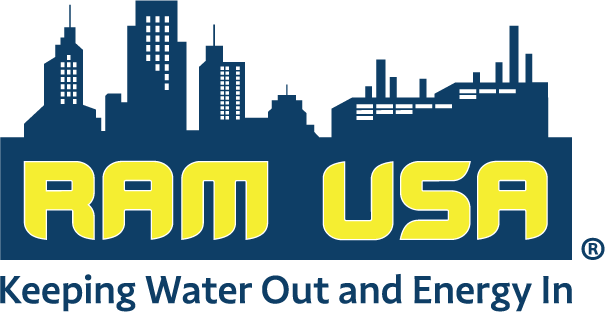Over the past six decades, building owners and managers have implemented various roof management plans.
The most common scenario is “set it and forget it.” This can be because the owner wants to “fix it when it fails” because a warranty says it’s covered, or because the roof needs to be replaced after a certain number of years. This can provide a few years of blissful ignorance. Still, it also potentially sets the owner up for an emergency roof replacement with rushed decisions based on limited choices at the end of the (shortened) life cycle.
The RAM USA Plan: “STAM” Strategic Testing And Monitoring
RAM USA uses state-of-the-art technology to test the system and determine the real age of the roof. For example, a poorly designed and installed roof could age quickly, while a well-built and maintained roof could last longer.
RAM USA wants to save your roofs! Even old roofs with leaks may not be an entire loss. Through diagnostic evaluations, RAM will identify the failed components for replacement and strengthen the weaker components for increased value. According to the National Roofing Contractor Association (NRCA), there are many reasons typical flat roofs are being replaced every 8-12 years. However, just decades ago, the NRCA found that the average longevity for a roof was 20+ years. Therefore, there’s a big difference between how roofs fail now and how they used to. This is caused by things like not paying enough attention, warranties not being easy to follow, and warranties not being an insurance policy.
It all boils down to the fact that too many good roofs are being replaced. Industry statistics and our experience show that roughly 50% of roofs being replaced don’t need to be! If facility owners/managers “feel” that their roofs need to be replaced, are told by a manufacturer or contractor that their roofs are bad, or are replacing roofs because “it’s time,” tons of good roofing material is being dumped into landfills every day. On top of being an enormous waste, many of these materials can cause a negative environmental impact.
What if there were some simple ways to combat these problems? As a registered roof consultant, RAM USA aims to provide these solutions. We have developed Roof Asset Management Programs incorporating the principles of Condition-based Maintenance (CbM). In its truest sense, CbM is performing maintenance on an asset based on the current performance level. One or more indicators that show deteriorating performance or approaching asset failure determine this need.
CbM can be expensive to implement, but it can prevent problems, speed up repairs, and save money. The Department of Defense has a policy that says condition-based maintenance (CbM) is necessary to improve maintenance agility and responsiveness, increase operational availability, and reduce life-cycle total ownership costs. CbM is “The Right Repair + The Right Timing = Best Value.”
CbM is an alternative to time-based maintenance (TbM), which is also referred to as “clock-based” maintenance or “calendar-based” maintenance. It is a form of maintenance according to a strict timetable (i.e., fixed intervals) between scheduled maintenance activities. TbM seems to be very prevalent in the realm of roof management.
For the sake of clarity in the conversation regarding roofs, let’s consider the word “maintenance” (the M in CbM) to mean a “roof repair.” This could be a major roof repair, restoration, or replacement. Basically, anything outside the realm of minor repairs or what is typically included in routine (semi-annual) roof inspections/surveys. These roof inspections are usually required for warranty compliance, and are often referred to as “routine maintenance.”
We recommend these inspections because they help us determine the condition of roofs. This includes diagnostics, physical assessments, and testing. In fact, that describes the initial stage of the three-step process we have developed to most efficiently extend the life of roof assets. RAM USA’s Asset Management Programs are designed around Information, Implementation, and Continuation.
The information stage is the crux of our program. It provides a complete condition baseline assessment with objective options for future proceedings. This is accomplished using our patent-pending aerial infrared scanning process and our Registered Roof Consultants (RRCs) performing “Boots on the Roof” Visual Roof Surveys. The findings were analyzed and published in a report outlining our recommended options in Prioritized 5-Year Plans. They are highly detailed with bankable budgets that empower the facility owner/manager to make the soundest business decisions proactively.
If the condition of any roof section indicates it needs repair, restoration, or replacement, we move into the Implementation Stage. RAM USA can help with these projects from beginning to end, or anywhere between. We can design and specify the roof project. We can offer advantages in bidding, project management, and monitoring services. A roofing statistic states that proper project monitoring can double the life of a roof!
Continuation is the last stage of our process. It is basically the repetition of the Information Stage in an ongoing manner. We have several annual or semi-annual Inspection/Maintenance Programs. Our inspections are important because they “continue” the initial plan. This way, we can know the condition of roof sections year in and year out. We can use this intelligence to make “The Right Repair at The Right Time,” providing The Best Value” for our clients.
Additionally, we tend to think of our programs as an investment in a thorough, proactive plan rather than an expense. The return on this investment can be significant. Would you spend 1% of your roof cost to achieve 50-100% more value? These services more than pay for themselves over time. So we feel facility owners/managers can’t afford NOT to use our Roof Asset Management Programs.







